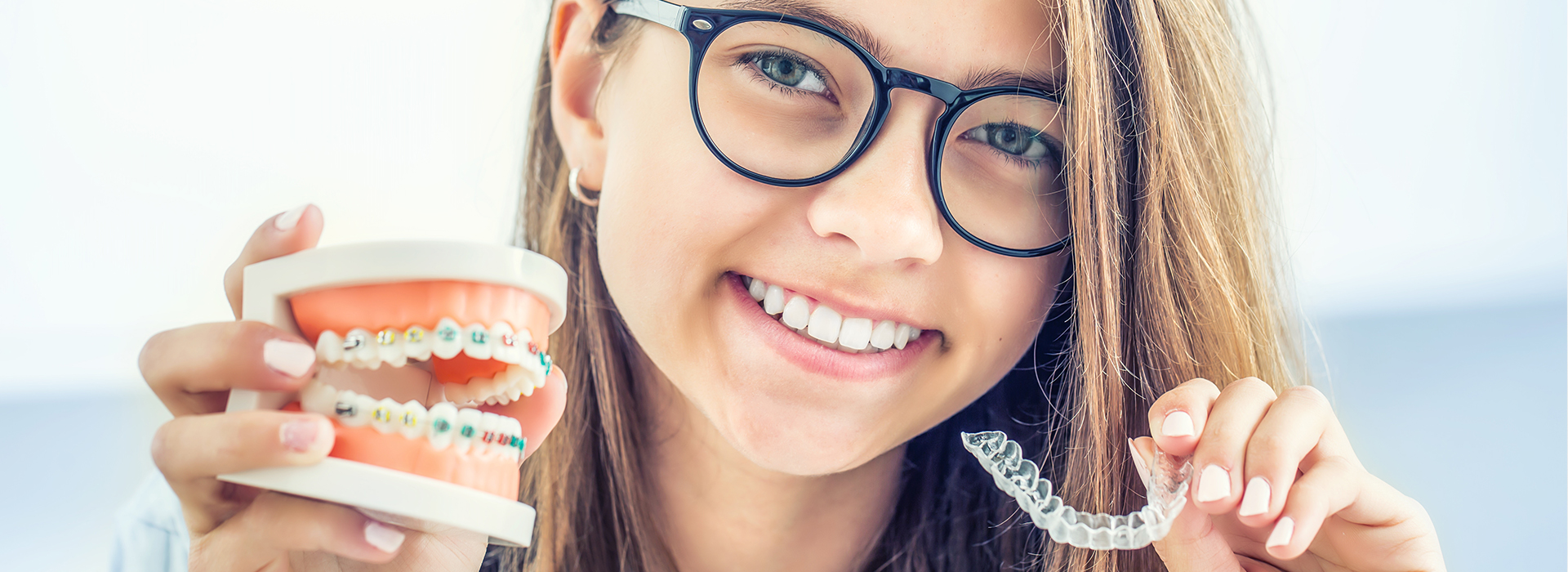
Orthodontics is more than a cosmetic upgrade — it is a branch of dental care focused on aligning teeth and jaws so they work together comfortably and last a lifetime. Whether a patient is dealing with crowded teeth, gaps, an uneven bite, or teeth that have shifted after extractions, properly planned orthodontic care restores both function and appearance. Thoughtful alignment preserves tooth structure, supports gum health, and can reduce the chance of future dental problems.
Treatment uses carefully calibrated appliances to guide teeth into healthier positions over time. Modern approaches apply gentler forces, use more precise planning tools, and offer a range of appliance styles to match patients’ goals and lifestyles. From minor tooth movement to full bite correction, the objective is the same: a stable, predictable result that enhances oral function and confidence.
Every treatment plan begins with a thorough evaluation: dental exam, dental history, and often digital imaging to map how teeth and jaws relate to one another. With that foundation, we can recommend an individualized path that considers growth in younger patients, the condition of supporting bone and gums in adults, and the patient’s personal priorities for appearance and comfort.
At Lesley Holloway the Dentist, our team blends clinical experience with patient-focused communication so people understand why a recommended course of care will benefit them. We aim to demystify orthodontics and help patients make confident decisions about the health and appearance of their smiles.
A straight smile often looks attractive, but the advantages extend far beyond aesthetics. Properly aligned teeth are easier to clean, which makes daily oral hygiene more effective and lowers the risk of decay and gum disease. When teeth fit together well, chewing is more efficient and the forces of biting are distributed evenly across the dental arch.
Teeth that are crowded or uneven can create tight spaces where plaque accumulates and toothbrush bristles cannot reach. Over time, those areas are more likely to develop cavities and periodontal problems. Aligning teeth improves access for brushing and flossing and helps protect the long-term health of enamel and gum tissue.
Alignment also affects jaw function. An unbalanced bite can place unusual stress on the temporomandibular joints, muscles, and teeth, leading to symptoms like jaw soreness, headaches, and uneven wear. Correcting the bite reduces these stresses and supports a more comfortable, resilient oral system.
Finally, a well-aligned smile contributes to overall well-being. Many people find that improved dental function and appearance boost self-confidence and encourage better oral care habits — a virtuous cycle that supports lasting dental health.

Choosing an orthodontic approach is a collaborative process that starts with an assessment of the problem, the patient’s age and growth potential, and their lifestyle preferences. Options today include conventional braces, ceramic brackets, lingual systems, self-ligating appliances, and removable clear aligners — each with advantages depending on the case.
For children, monitoring jaw growth and tooth eruption is essential. Early evaluations allow us to identify developing issues and, when indicated, begin interceptive treatment to guide jaw growth or preserve space for incoming adult teeth. Many full-course treatments still start in the preteen and early teen years when growth can be advantageous for correcting skeletal relationships.
Adults also benefit from a wide range of solutions. Because adult mouths may show signs of previous dental work, periodontal changes, or wear, treatment planning focuses on restoring both the appearance and the long-term health of the smile. In many cases, clear aligners or discreet bracket options offer effective results with minimal impact on daily life.
Which method is right depends on factors like the degree of crowding or spacing, bite relationships between the upper and lower jaws, whether extractions are necessary, any supportive appliances needed, and patient compliance. We review these elements with patients and explain the anticipated timeline so expectations are clear from the outset.
A comprehensive orthodontic exam typically includes a clinical assessment, digital photographs, and radiographs or 3-D imaging when needed. These tools let us measure tooth positions, analyze how the jaws fit together, and identify underlying skeletal considerations that influence treatment choices. We use that data to build a customized plan with predictable steps and measurable goals.
Severity of the bite problem, gum and bone health, the patient’s growth stage, and daily routines all influence which appliances will be most effective. Patient cooperation — for example, wearing aligners as directed or maintaining excellent oral hygiene with braces — plays a major role in achieving efficient and lasting outcomes.

Orthodontics has evolved considerably over recent decades. Advances in materials and digital planning allow for more precise, comfortable, and discreet treatment than ever before. Smaller brackets, tooth-colored options, and lingual systems have reduced the visibility of appliances, while clear aligner therapy offers a removable alternative for many cases.
Digital technology plays a central role: intraoral scanners replace messy impressions, 3-D imaging clarifies complex anatomical relationships, and software helps visualize tooth movement through every phase of treatment. These tools improve predictability and let patients see expected outcomes before appliances are placed.
Other contemporary options — such as temporary anchorage devices (TADs) and accelerated orthodontic techniques — can help manage difficult tooth movements or shorten specific phases of care when clinically appropriate. Our practice stays current with these developments so we can recommend the most effective, evidence-based approach for each patient.
Clear aligners have become a popular option because they combine aesthetic discretion with treatment flexibility. Custom-fabricated for each stage of movement, aligners are replaced in a prescribed sequence that gently guides teeth into new positions. Because they are removable, aligners make oral hygiene simpler during treatment and impose fewer dietary restrictions.
While aligners solve many cases, fixed braces remain the gold standard for certain complex movements and precise control of tooth rotation and root positioning. Bracket-and-wire systems are highly reliable and remain an essential tool in comprehensive orthodontic care.
Completing active tooth movement is a major milestone, but maintaining that result is the final, essential phase of care. After appliances are removed, retainers are prescribed to hold teeth in their new positions while the surrounding tissues and bone adapt. The exact type and duration of retention are tailored to each patient’s needs.
Teeth can drift over time because of biological factors and daily function. The fibers that connect teeth to bone have memory, and without retention they may gradually pull teeth back toward their original positions. Wearing retainers as directed helps the tissues reorganize and secures the investment of treatment.
Even with excellent orthodontic work, ongoing dental care matters. Regular dental checkups, strong oral hygiene, and attention to habits that affect alignment (such as grinding or tongue posture) help preserve the outcome. We partner with patients to establish practical retention plans that fit their lifestyle and deliver lasting benefits.

Straightening your teeth is an investment in oral health, function, and confidence. If you’re curious about orthodontic options for yourself or a family member, our team will explain the clinical reasoning behind each recommendation and outline a clear plan tailored to your goals. Contact us to learn more and discuss whether orthodontic care is right for you.
Orthodontics is the dental specialty focused on diagnosing, preventing, and correcting misalignments of the teeth and jaws so they function together comfortably. Common issues treated include crowded or spaced teeth, bite discrepancies such as overbite or crossbite, and teeth that have shifted after extractions or dental work. The goal is to establish a stable bite that supports chewing, speech, and long-term oral health.
Properly planned orthodontic care also preserves tooth structure and gum support by improving access for daily cleaning and reducing abnormal wear. Treatment can range from minor tooth movement to full skeletal correction depending on the underlying problem. Careful planning helps deliver predictable results that balance function and appearance.
Aligning teeth makes them easier to clean, which lowers the risk of cavities and periodontal disease by reducing plaque-trapping areas. When teeth meet properly, biting forces are distributed evenly across the dental arch, which helps prevent excessive wear, tooth fracture, and uneven stress on supporting tissues. Improved alignment can also reduce strain on the jaw joints and muscles that may contribute to chronic pain or headaches.
Orthodontic correction often complements other dental care by creating a more stable foundation for restorations and prosthetics. In many cases, moving teeth into ideal positions enhances the prognosis of adjacent dental treatments and supports long-term oral health. Patients who experience functional improvement also tend to maintain better hygiene habits, reinforcing the benefits of treatment.
Candidates for orthodontic care include children, adolescents, and adults who have tooth alignment or bite problems that affect function, hygiene, or appearance. A thorough evaluation of dental and gum health is essential because active periodontal disease or poor bone support may require stabilization before active tooth movement. Growth considerations are important for younger patients, while adults may need additional assessment of previous dental work and overall oral health.
Many issues can be treated across a wide age range, but the recommended approach and timing depend on the problem and the patient’s goals. Cooperation with appliances, commitment to oral hygiene, and regular appointments are critical factors that influence candidacy and the likelihood of a successful outcome. We tailor recommendations to each individual so treatment is both safe and effective.
Modern orthodontics offers a variety of appliances, including traditional metal braces, ceramic brackets that blend with tooth color, lingual braces placed behind the teeth, and removable clear aligners. Each appliance type provides different levels of control, aesthetics, and comfort. Fixed systems are bonded to the teeth and excel at complex movements, while removable systems offer convenience and easier hygiene for many patients.
Advances such as self-ligating brackets, smaller hardware, and refined archwire technology improve comfort and efficiency in many cases. The choice of appliance depends on the nature and severity of movement required, patient preference, and lifestyle considerations. We review these factors with patients to select the most appropriate and evidence-based option for their needs.
Clear aligner therapy uses a series of custom-made, removable trays that progressively reposition teeth by applying gentle, controlled forces. Aligners are exchanged at prescribed intervals to guide tooth movement through each planned stage, and they are typically worn most of the day to be effective. Digital planning and intraoral scanning are commonly used to design the sequence of movements and to visualize expected outcomes before treatment begins.
Aligners are especially well suited to mild and moderate spacing or alignment issues and are popular with patients who want a discreet option. They make oral hygiene simpler because trays can be removed for brushing and flossing, but success depends on patient compliance with wear time. For more complex movements, fixed appliances may still offer superior control.
Fixed braces are often preferred when precise control of tooth movement is needed, such as rotating teeth, moving roots, or correcting vertical discrepancies. Bracket-and-wire systems provide continuous, predictable forces and allow the clinician to make incremental adjustments during treatment. These systems are also beneficial for patients who may not reliably wear removable appliances for the required amount of time.
Complex bite corrections, significant crowding, and cases that require auxiliary devices or anchorage control are frequently managed more efficiently with fixed appliances. The decision between fixed and removable options is made after a careful clinical assessment and discussion of the desired outcomes and practical considerations for the patient.
A comprehensive evaluation typically involves a clinical exam, review of dental and medical history, digital photographs, and diagnostic imaging such as radiographs or 3-D scans when indicated. These records help analyze tooth positions, jaw relationships, and any underlying skeletal factors that influence treatment planning. The team also assesses gum and bone health to ensure a safe environment for tooth movement.
Using this information, the clinician explains the recommended treatment options, anticipated sequence of care, and an estimated timeline for active movement and retention. Patients are informed about any adjunctive needs, such as extractions, temporary anchorage devices, or collaboration with other dental specialists. Clear communication helps set realistic expectations and supports shared decision making.
Treatment duration varies widely but commonly ranges from about a year to several years depending on the complexity of the case and the methods used. Mild alignment issues may be resolved more quickly, while comprehensive bite corrections require more time to reposition teeth and allow surrounding tissues to adapt. Biological factors such as the rate of bone remodeling, patient age, and growth patterns also influence how quickly teeth respond to treatment.
Patient-related factors like appliance wear compliance, oral hygiene, and attending scheduled appointments are crucial to staying on track with the plan. Occasionally, unexpected issues such as the need for additional procedures or breaks in treatment will extend the timeline. Regular monitoring and proactive management help keep treatment efficient and predictable.
Maintaining excellent oral hygiene is essential throughout orthodontic care to prevent decay and gum problems. For patients with braces, this includes thorough brushing around brackets and wires, using interdental brushes or floss threaders, and following any specific cleaning instructions from the team. Those using clear aligners should remove trays for eating, clean them as instructed, and continue consistent brushing and flossing to protect enamel and gum tissue.
Dietary precautions help protect fixed appliances; avoiding hard, sticky, or overly crunchy foods reduces the risk of damage. Promptly report loose brackets, broken wires, or unusually persistent discomfort so the team can make timely repairs. Regular checkups allow the clinician to monitor oral health, make adjustments, and reinforce techniques that support a smooth course of treatment.
To begin, schedule a comprehensive orthodontic evaluation where the team will review your dental history, perform an exam, and obtain any necessary digital records. The clinician will discuss which treatment options are appropriate for your specific needs, explain the expected sequence of care, and answer questions about appliances and retention. This visit is an opportunity to understand the clinical reasoning behind recommendations and to set clear goals for treatment.
If you are ready to proceed, the practice will coordinate next steps such as scans, photographs, and treatment planning appointments to create a personalized plan. For scheduling and more information you can call (402) 256-3231 or visit the office at 124 E 2nd St., Laurel, NE 68745 to speak with a member of the team. We aim to make the process approachable and well explained so patients can move forward with confidence.
Quick Links
Contact Us